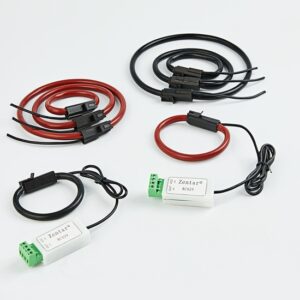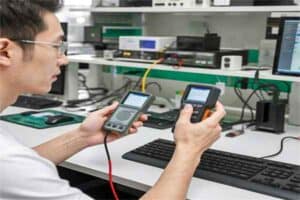[vc_row][vc_column][vc_column_text]Electrical debugging is a key content in power installation engineering project work. In electrical debugging work, secondary loop inspection is also a key adjustment content. It is related to the precise measurement, maintenance, and communication of the power supply system. A prerequisite that cannot be fully utilized. In the secondary loop, whether the wiring of the transformer is appropriate is also the basis of whether the secondary loop of the current is appropriate, so the wiring accuracy of the current transformer is very critical.
- Wiring standard of current transformer (1) No open circuit is allowed on the secondary side of the transformer. The secondary open circuit is likely to cause serious harm. One is the overheating of the inductance coil, which may even damage the transformer; the other is because there are many turns of the secondary winding coil, which will induce a high voltage at the risk of the electromagnetic coil, which will seriously endanger personal safety and industry. The safety performance of the equipment.
Transformer
(2) The secondary side of the high voltage current transformer should be grounded as much as possible. Because the primary side of the transformer is high voltage, when the primary and secondary magnet electromagnetic coils are destroyed by the insulating sleeve and the high voltage passes through, the high voltage will be embedded into the low voltage. If the secondary magnet electromagnetic coil is grounded at one point, the high voltage will be introduced. The ground can ensure personal safety and the safety performance of industrial equipment. But it should be noted that the secondary circuit of the current transformer is only allowed to be grounded at one point, and no grounding is allowed, otherwise it may cause shunting and damage the application. The secondary magnet electromagnetic coil of the low voltage current transformer should not be grounded. Because the working voltage of the low-voltage transformer is low, the insulation sleeve between the primary and secondary magnet electromagnetic coils has a high degree of desire, resulting in a small probability of passing the primary and secondary magnet electromagnetic coils. In addition, the secondary magnet electromagnetic coil is not grounded. It will improve the working skills of the insulating bushings of the secondary circuit and the instrument panel, and reduce the incidence of safety accidents of the instrument panel damaged by lightning. In addition, the differential protection is composed of differential protection relays (such as BCH-2, etc.). The current transformers on both sides of the differential protection are only grounded at one point. Generally, the grounding point is built at the protection screen. When protecting mechanical equipment, the current transformers on both sides should be grounded separately.
(3) The precise measurement level and maintenance level of the current transformer cannot be reversed. Because the thickness of the inductance coil design for precise measurement and maintenance of the winding is different, if it is inserted reversely, the accuracy of the precise measurement in normal operation will be reduced, and the electromagnetic energy measurement verification will not be accurate enough; the second will cause common problems in short-circuit faults. , Because the design scheme of the inductance coil of the measurement verification winding ensures that the inductance coil is saturated when the short-circuit current exceeds a certain rate of the rated voltage, which limits the increase in the amount of secondary current to maintain the instrument panel. The relay protection winding inductance coil is unsaturated fat, and the secondary current is correspondingly expanded with the short-circuit capacity, so that the relay protection has a precise posture. If it is inserted reversely, the relay protection action is not flexible, and the metering verification instrument panel is likely to be destroyed.
Transformer
(4) Because the secondary winding of the current transformer cannot be opened, the windings that are not needed by the current transformer should be wired as much as possible. However, there are many tapped current transformers, and the unneeded taps should not be connected. For example, a current transformer secondary has taps 1S1, 1S2, 1S3, where 1S1, 1S2 are 300/5A, 1S1, 1S3 It is 600/5A. When using 300/5A as much as possible, connect to 1S1 and 1S2 applications. 1S1 and 1S3 should not be connected, otherwise the measurement accuracy of the application tap will be damaged.
(5) The measurement verification winding of the current transformer and the connection of the relay protection winding involving the position should grasp two points to establish the connection. One is to look at the installation position of the current transformer, that is, to establish which side the L1 of the current transformer is installed; It depends on the function of the winding or the type of relay protection. With the above two points, the connection of the current transformer can be established again.
- Common problems of current transformer application
(1) The polarity connection must be connected in pairs. Current transformers are generally marked by minus polarity. If the polarity is incorrectly connected, it will affect the measurement verification, and even when several current transformers are connected in the same route, it will all lead to short-circuit failure safety problems.
(2) The secondary circuit should have a defensive grounding point and be connected reliably. In order to prevent the high voltage from entering the low voltage side after the primary and secondary winding intermediate insulation sleeves pass through and seriously endanger personal safety and instrument panel safety performance, a defensive grounding point must be set on the secondary side of the current transformer, and only one grounding point is allowed to be connected. Generally, the terminal of the box body close to the current transformer is grounded.
(3) The secondary winding is not allowed to be open during operation. Otherwise, it will cause the following serious hazards: high voltage on the secondary side, which seriously endangers personal safety and instrument panel safety performance; causes over-temperature, which is likely to destroy the windings; expand the measurement verification deviation.
(4) The secondary circuit of the current transformer used for electromagnetic energy measurement and verification shall not be connected with relay protection machinery and equipment, maintenance machinery and equipment, etc., to prevent mutual damage.
[/vc_column_text][/vc_column][/vc_row][vc_row][vc_column]




